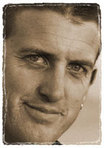Building a fantasy world: the map of Eyri
All good epic fantasy stories have a map. I suppose you're thinking of Lord of the Rings, but my first epic fantasy was Winnie-the-Pooh. Really? A.A. Milne is often overlooked as a fantasy author, yet most people would have no problem classifying Watership Down by Richard Adams as animal fantasy, or even heroic fantasy. Pooh Bear was my first hero. He went on quests. He had companions. Strange creatures inhabited his world, but I grew to love them all, even the terrifying Woozles. And right at the start, there was a map, which I could pore over and imagine all the adventures that could happen, and what the places might be like.
Some of that wonder of discovery has followed me all my life: it's why I'm a paragliding pilot, and a writer of fantasy. Thanks Pooh! So when I sat down to craft my fantasy world that would become The Riddler's Gift, I first drew a map.
It's not like Tolkien's map; it's not trying to be. It is more like the Hundred Acre wood. What I'm trying to tell my readers is this: the story world is somewhere you've never been before so you need a map, but it's small enough that you can grasp it all. I was also thinking of The Little Prince by Antoine de Saint-Exupéry, who had a little planet to himself. The Riddler's Gift takes place in Eyri, which is its own little protected world. It's intentionally simple. You know there's probably more to the The Tale of the Lifesong than this little kingdom, but it's a welcoming place to begin.
I discovered, as I descended into this apparently small kingdom, that there was more than enough going on to keep us occupied. We didn't need to go beyond the visible horizon to find adventures and interesting characters and stories to be told. Having a lake at the centre and a rim of mountains meant the whole landscape sloped conveniently down to the centre, and so wherever a chase began it would end up converging on Stormhaven. This helped to direct things towards a climax and suggested where the end of the book should take place.
Drawing a map before the story is very useful, because you can plot things out accurately, like the time it would take to get from Levin to First Light on horseback, whether a cart driven by a tricky Riddler could get to Southwind in that same time, and how long you'd need to limp along the shore from Southwind to Fendwarrow, grinding your teeth after nearly drowning in the Amberlake.
The views became clear (when writing a dawn scene in First Light, what do you see looking east?). And you can probably guess why that village gets its name, being high up on an east-facing slope (don't be tricked by the setting sun, nearby). The map helped me to see how the kingdom could be self-sustaining for so long, with a timber-yard at Llury, vegetables around Hillow, boatyards at Wright, fishing markets at Southwind, flour made in Westmill, mining at Chink and Coppershaft, farming in Meadowmoor county and fruit around Flowerton, just to begin with. These elements help to remind me what the people would be like as we pass through their villages with the flow of the story, and what would be going on in streets.
Of course, once my readers are ready to venture beyond Eyri with Tabitha (in the Second Tale of the Lifesong), there's Oldenworld to map out. That task could take us a lifetime. But there's nothing as exciting as opening up an unseen map, and being presented with a whole world to explore. Maps are what make fantasy epic.




